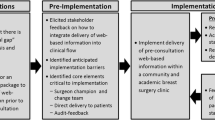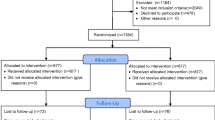Abstract
This article explores the use and evaluation of a pre-visit website which aims to prepare counselees who are the first in their family to request breast cancer genetic counseling. This website E-info geneca provides computer-tailored information and a blank question prompt sheet (QPS) on which counselees can formulate their questions for the consultation. The objectives of this study are: first, to assess which factors influence the use of E-info geneca, including the duration of site and page views, the influence of topic sequence in the menu bar on the sequence of page views, and the relation between website use and the use of the QPS; second, to explore counselees’ evaluations of E-info geneca and relations with counselee characteristics. User statistics were analyzed to describe duration of site and page views. Multivariate analyses were used to predict duration of web and page views, sequence of page views, QPS use, and site evaluations. Independent variables were sociodemographic background, disease status, psychological functioning, and information needs. All 101 counselees who were provided with a login accessed the website and spent, on average, 21 min viewing the website. Counselees affected with breast cancer spent more time on the website than unaffected counselees. Half of all page views were within the sequence of topics in the menu and older counselees, and those who made less use of the internet more often navigated according to the menu sequence than others. Having viewed information about why it is important to ask questions increased QPS use. Counselees who had higher information needs considered the information more helpful. This hospital-provided website for breast cancer genetic counselees was accessible and was evaluated positively, even concerning older counselees and those who had not searched the internet for information about hereditary cancer. Counselees might navigate hospital-provided websites more in line with the sequence of topics in the menu bar, than generally accessible health websites.

Similar content being viewed by others
References
Biesecker BB (2001) Goals of genetic counseling. Clin Genet 60:323–330
Henneman L, Timmermans DR, Van der Wal G (2004) Public experiences, knowledge and expectations about medical genetics and the use of genetic information. Community Genet 7:33–43
Morren M, Rijken M, Baanders AN, Bensing J (2007) Perceived genetic knowledge, attitudes towards genetic testing, and the relationship between these among patients with a chronic disease. Patient Educ Couns 65:197–204
Hallowell N, Murton F, Statham H, Green JM, Richards MPM (1997) Women’s need for information before attending genetic counselling for familial breast or ovarian cancer: a questionnaire, interview, and observational study. Br Med J 314:281–283
Pieterse A, Van Dulmen S, Ausems M, Schoemaker A, Beemer F, Bensing J (2005) QUOTE-geneca: development of a counselee-centered instrument to measure needs and preferences in genetic counseling for hereditary cancer. Psychooncology 14:361–375
Metcalfe A, Werrett J, Burgess L, Clifford C (2007) Psychosocial impact of the lack of information given at referral about familial risk for cancer. Psychooncology 16:458–465
Pieterse AH, Van Dulmen AM, Ausems MGEM, Beemer FA, Bensing JM (2005) Communication in cancer genetic counselling: does it reflect counselees’ pre-visit needs and preferences? Br J Cancer 92:1671–1678
Meiser B, Irle J, Lobb E, Barlow-Stewart K (2008) Assessment of the content and process of genetic counseling: a critical review of empirical studies. J Genet Couns 17:434–451
Butow P, Lobb E (2004) Analyzing the process and content of genetic counseling in familial breast cancer consultations. J Genet Couns 13:403–424
Ellington L, Roter D, Dudley WN, Baty BJ, Upchurch R, Larson S, Wylie JE, Smith KR, Botkin JR (2005) Communication analysis of BRCA1 genetic counseling. J Genet Couns 14:377–386
Pieterse AH, Ausems MGEM, Van Dulmen AM, Beemer FA, Bensing JM (2005) Initial cancer genetic counseling consultation: change in counselees’ cognitions and anxiety, and association with addressing their needs and preferences. Am J Med Genet A 137:27–35
Albada A, Van Dulmen S, Otten R, Bensing JM, Ausems MGEM (2009) Development of E-info gene(ca): a website providing computer-tailored information and question prompt prior to breast cancer genetic counseling. J Genet Couns 18:326–338
Lustria ML, Cortese J, Noar SM, Glueckauf RL (2009) Computer-tailored health interventions delivered over the web: review and analysis of key components. Patient Educ Couns 74:156–173
Wantland DJ, Portillo CJ, Holzemer WL, Slaughter R, McGhee EM (2004) The effectiveness of Web-based vs. non-Web-based interventions: a meta-analysis of behavioral change outcomes. J Med Internet Res 6:e40
Nguyen HQ, Carrieri-Kohlman V, Rankin SH, Slaughter R, Stulbarg MS (2004) Internet-based patient education and support interventions: a review of evaluation studies and directions for future research. Comput Biol Med 34:95–112
Proudfoot J, Parker G, Hyett M, Manicavasagar V, Smith M, Grdovic S, Greenfield L (2007) Next generation of self-management education: web-based bipolar disorder program. Aust N Z J Psychiatry 41:903–909
Tian H, Brimmer DJ, Lin JM, Tumpey AJ, Reeves WC (2009) Web usage data as a means of evaluating public health messaging and outreach. J Med Internet Res 11:e52
Revere D, Dunbar PJ (2001) Review of computer-generated outpatient health behavior interventions: clinical encounters “in absentia”. J Am Med Inform Assoc 8:62–79
Albada A, Ausems MGEM, Bensing JM, Van Dulmen S (2009) Tailored information about cancer risk and screening. Patient Educ Couns 77:155–171
Fogel J, Albert SM, Schnabel F, Ditkoff BA, Neugut AI (2002) Use of the internet by women with breast cancer. J Med Internet Res 4:E9
Pereira JL, Koski S, Hanson J, Bruera ED, Mackey JR (2000) Internet usage among women with breast cancer: an exploratory study. Clin Breast Cancer 1:148–153
Chen X, Siu LL (2001) Impact of the media and the internet on oncology: survey of cancer patients and oncologists in Canada. J Clin Oncol 19:4291–4297
Van de Poll-Franse LV, van Eenbergen MC (2008) Internet use by cancer survivors: current use and future wishes. Support Care Cancer 16:1189–1195
U.S. Department of Health and Human Services, U.S. General Services Administration (2008) Research-based web design & usability guidelines. U.S Department of Health and Human Services, Washington, DC
Ley P (1979) Memory for medical information. Br J Soc Clin Psychol 18:245–255
Dimoska A, Tattersall MHN, Shepherd H, Kinnersley P (2008) Can a “Prompt List” empower cancer patients to ask relevant questions? Cancer 113:225–237
Van der Meulen N, Jansen J, Van Dulmen S, Bensing J, van Weert J (2008) Interventions to improve recall of medical information in cancer patients: a systematic review of the literature. Psychooncology 17:857–868
Fischer M, Visser A, Voerman B, Garssen B, Van den Andel G, Bensing J (2006) Treatment decision making in prostate cancer: patients’ participation in complex decisions. Patient Educ Couns 63:308–313
Pieterse AH, Dulmen AMV, Beemer FA, Bensing JM, Ausems MGEM (2007) Cancer genetic counseling: communication and counselees’ post-visit satisfaction, cognitions, anxiety, and needs fulfillment. J Genet Couns 16:85–96
Wells T, Falk S, Dieppe P (2004) The patients’ written word: a simple communication aid. Patient Educ Couns 54:197–200
Green JM, Fost N (1997) An interactive computer program for educating and counseling patients about genetic susceptibility to breast cancer. J Cancer Educ 12:204–208
Green MJ, Biesecker BB, McInervey AM, Mauger D, Fost N (2001) An interactive computer program can effectively educate patients about genetic testing for breast cancer susceptibility. Am J Med Genet 103:16–23
Green MJ, Peterson SK, Baker MW, Friedman LC, Harper GR, Rubinstein WS, Peters JA, Mauger DT (2005) Use of an educational computer program before genetic counseling for breast cancer susceptibility: effects on duration and content of counseling sessions. Genet Med 7:221–229
Kreuter MW, Strecher VJ, Glassman B (1999) One size does not fil all: the case for tailoring print materials. Ann Behav Med 21:276–283
Jones RB, Pearson J, Cawsey AJ, Bental D, Barrett A, White J, White CA, Gilmour WH (2006) Effect of different forms of information produced for cancer patients on their use of the information, social support, and anxiety: randomised trial. BMJ 332:942–948
Skinner CS, Schildkraut JM, Berry D, Calingaert B, Marcom PK, Sugarman J, Winer EP, Iglehart JD, Futreal PA (2002) Pre-counseling education materials for BRCA testing: does tailoring make a difference? Genet Test 6:93–105
Kreuter MW, Wray RJ (2003) Tailored and targeted health communication: strategies for enhancing information relevance. Am J Health Behav 27:S227–S232
Walters ST, Wright JA, Shegog R (2006) A review of computer and Internet-based interventions for smoking behavior. Addict Behav 31:264–277
Brug J, Oenema A, Campbell M (2003) Past, present, and future of computer-tailored nutrition education. Am J Clin Nutr 77:1028S–1034S
Cassileth BR, Zupkis RV, Sutton-Smith K, March V (1980) Information and participation preferences among cancer patients. Ann Intern Med 92:832–836
Zandbelt LC, Smets EM, Oort FJ, Godfried MH, de Haes HC (2006) Determinants of physicians’ patient-centred behaviour in the medical specialist encounter. Soc Sci Med 63:899–910
Lerman C, Trock B, Rimer BK, Boyce A, Jepson C, Engstrom PF (1991) Psychological and behavioral implications of abnormal mammograms. Ann Intern Med 114:657–661
Spielberger CD (1983) Manual of the state-trait anxiety inventory. Consulting Psychologists Press, Palo Alto
Van der Ploeg HM, Defares PB, Spielberger CD (1980) Manual of the Dutch version of the state trait anxiety inventory [Handleiding bij de Zelfbeoordelings Vragenlijst (ZBV)]. Swets and Zeitlinger, Lisse
STOET, Association Clinical Genetics Netherlands, Working group Clinical Oncogenetics (2005) Hereditary tumors: Guidelines for diagnostics and prevention [Erfelijke tumoren: Richtlijnen voor diagnostiek en preventie]. www.stoet.nl
Dijkstra A (2008) The psychology of tailoring. Ingredients in computer-tailored persuasion. Soc Person Psychol Comp 2:765–784
Hawkins RP, Kreuter M, Resnicow K, Fishbein M, Dijkstra A (2008) Understanding tailoring in communicating about health. Health Educ Res 23:454–466
Butow P, Devine R, Boyer M, Pendlebury S, Jackson M, Tattersall MH (2004) Cancer consultation preparation package: changing patients but not physicians is not enough. J Clin Oncol 22:4401–4409
Han JY, Wise M, Kim E, Pingree R, Hawkins RP, Pingree S, McTavish F, Gustafson DH (2010) Factors associated with use of interactive cancer communication system: an application of the comprehensive model of information seeking. J Comput-Mediat Commun 15:367–388
Colijn JJ (2010) Use and appreciation of Kiesbeter.nl in the year of 2009 [Gebruik en waardering van Kiesbeter.nl in 2009]. National Institute for Public Health and Environment, Utrecht
Julian-Reynier CJ, Eisinger F, Chabal F, Aurran Y, Bignon YJ, Noguès C, Machelard-Roumagnac M, Maugard C, Vennin P, Sobol H (1998) Cancer genetic clinics: why do women who already have cancer attend? Eur J Cancer 34:1549–1553
Meyer B, Sit RA, Spaulding VA, Mead SE, Walker N (1997) Age group differences in world wide web navigation. http://sigchi.org/chi97/proceedings/short-talk/bm.htm CHI 97 Electronic Publications: Late-Breaking/Short Talks
Zaphiris P, Kurniawan S, Ghiawadwale M (2010) A systematic approach to the development of research-based web design guidelines for older people. Univ Access Inf Soc 6:59–75
Jones R, Pearson J, McGregor S, Barrett A, Harper GW, Atkinson JM, Cawsey AJ, McEwen J (2002) Does writing a list help cancer patients ask relevant questions? Patient Educ Couns 47:369–371
Davison BJ, Degner LF (2002) Feasibility of using a computer-assisted intervention to enhance the way women with breast cancer communicate with their physicians. Cancer Nurs 25:417–424
Brown R, Butow PN, Boyer MJ, Tattersall MHN (1999) Promoting patient participation in the cancer consultation: evaluation of a prompt sheet and coaching in question-asking. Br J Cancer 80:242–248
Festinger L (1962) A theory of cognitive dissonance. Stanford University Press, Stanford
Acknowledgements
We are grateful to Ms. A. Wallet, secretary of the department of Medical Genetics of the UMCU, and Ms. D. Saya, secretary of Nivel, for organizing practicalities of the study. Also, we thank all counselees who participated in this research. This study was funded by the Dutch Cancer Society (Nivel 2006–3469).
Author information
Authors and Affiliations
Corresponding author
Rights and permissions
About this article
Cite this article
Albada, A., Ausems, M.G.E.M., Otten, R. et al. Use and Evaluation of an Individually Tailored Website for Counselees Prior to Breast Cancer Genetic Counseling. J Canc Educ 26, 670–681 (2011). https://doi.org/10.1007/s13187-011-0227-x
Published:
Issue Date:
DOI: https://doi.org/10.1007/s13187-011-0227-x




